June 16, 2025 | 15:24 GMT +7
June 16, 2025 | 15:24 GMT +7
Hotline: 0913.378.918
June 16, 2025 | 15:24 GMT +7
Hotline: 0913.378.918
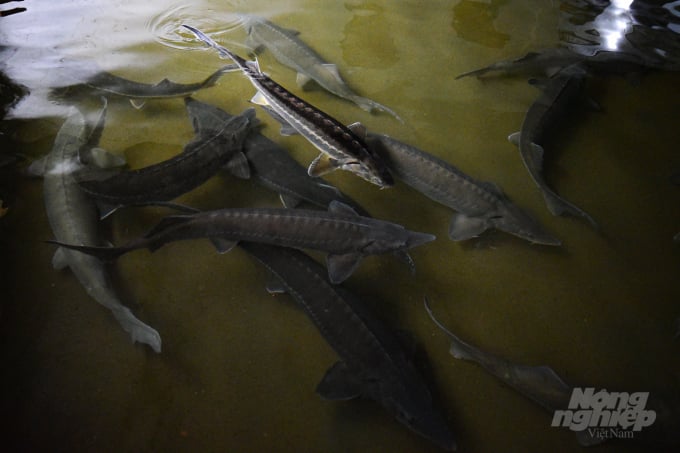
Sturgeons in Dr. Le Thanh Luu's farm weigh up to 10-15 kg. Photo: Tung Dinh.
After more than 10 years of operation, the sturgeon farm of Dr. Le Thanh Luu, former Director of the Research Institute for Aquaculture 1 (RIA1 - Ministry of Agriculture and Rural Development), now produces 18 tons of meat and 150kg of eggs per year at its peak.
This sturgeon farm is located in Nam Xe commune, Van Ban district (Lao Cai), primarily raising Russian sturgeon, Siberian sturgeon and sterlet. The breed source is completely imported from Russia and Hungary. Russian and Siberian sturgeon are raised for meat and sterlets are raised for eggs.
According to Dr. Luu, the sterlet were chosen to be raised for eggs owing to the biological characteristics of its early eggs. The eggs take only four to harvest while other species such as Russian and Siberian sturgeon take eight years, and thirteen years in the case of belugas.
In addition to this quick harvesting period, sterlet farmers can follow a balanced and long-term harvest. “Sterlet gives eggs once a year, even three times in two years if the conditions are good, not to mention each one has a life cycle of up to 20 years,” said Dr. Luu.
Possessing a castle of knowledge and decades of experience with sturgeon, Dr. Luu has achieved an extraordinary feat: 100% of the chosen female sterlets hold eggs. This rate is only 20-30% when they are raised using the common method.

Dr. Luu (left) demonstrating his way of harvesting eggs. Photo: Tung Dinh.
Dr. Luu has his own secret technique to acquire eggs while keeping the fish alive. "Usually the fish are cut open in order to get the eggs, but we have a way to pat out the eggs while keeping them alive. The eggs remain fresh, clean and delicious," said the RIA1 former Director.
Post-maturity sterlet will no longer grow, only producing eggs on an annual cycle. The adult’s weight ranges from 2 to 5 kg. Although rare, there are exceptional specimen in the wild able to weigh up to 7 kg. As for adult females, their eggs can account for 15-20% of their body weight.
The selling price of sterlet eggs at Dr. Luu's farm is USD 800/kg at the moment.
Bursting with life as seedlings - delicious as meat
Having acquired the technique and breed sources in Europe, Dr. Luu produces the seed for himself and his fellow locals also raising sturgeon. He imports sturgeon eggs from Russia and Hungary, incubates and reares the juveniles until they reach a length of approximately 20 cm, then sells the seedlings.
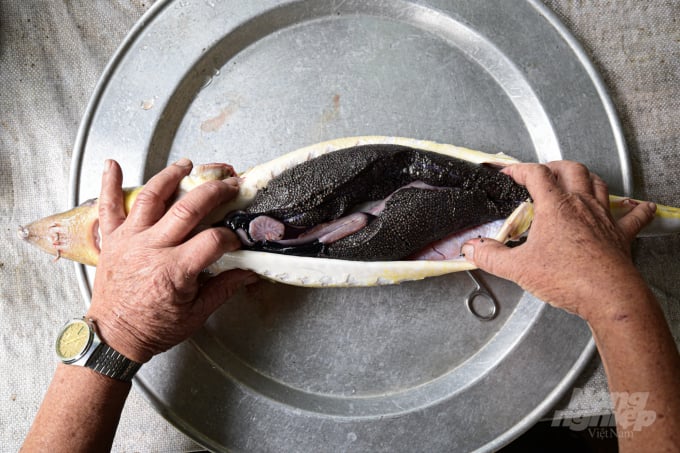
The sterlet raised by Dr. Luu are ready for eggs. Photo: Tung Dinh.
Dr. Luu stated that his fingerlings not only have a survival rate of approximately 100% but also grow well. The farm’s fingerling productivity is currently 250,000 - 300,000 fish per year.
Dr. Luu's farm raises Russian sturgeon and Siberian sturgeons for meat with an average density of 2.5 tons/100 m2. Dr. Luu and his colleagues can raise 18 tons of sturgeon for meat each year, selling on-site for an average price of 200,000 VND/kg.
The two varieties possess complementary properties. While Siberian sturgeon grows quickly and has soft flesh, Russian sturgeon grows slower but gives firmer and whiter flesh. According to Dr. Luu, Siberian sturgeon only needs 18 months to reach the 2.5-3 kg weight range, but with Russian sturgeon it may take at least 2 years.
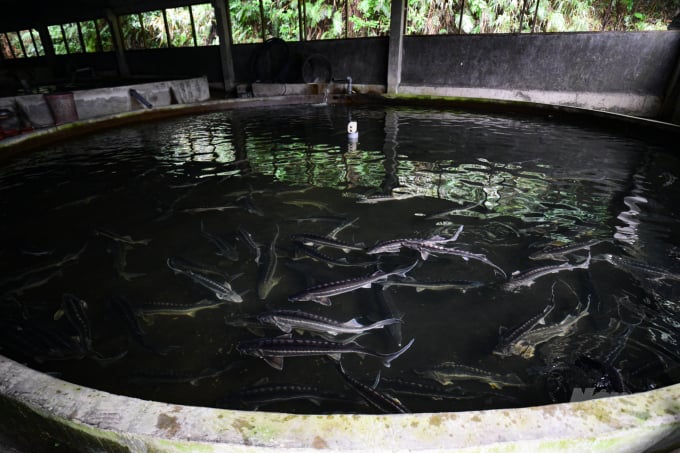
Dr. Luu's farm currently focuses on breeding fingerlings and sturgeons for meat. Photo: Tung Dinh.
One limitation of the farm is that there is no electricity grid, so up to now cultivation and production are still executed naturally, unable to fully apply many technologies.
“A complete setup of an electrical grid will lead to investments in filters, aerators, and oxygen generators to ensure oxygen for fish, increasing the density and thus doubling the productivity," said Dr. Luu.
Solving the above problem may serve as a means for him and his colleagues to invest more in building accommodation areas, turning fish farms into a production model to guide the locals to help them follow.
However, in order to have access to his technique, Dr. Luu has certain conditions: "My condition for cooperation is that there must be a bio-secure farming facility, if not yet I can support the design with a negligible amount of materials. It is also necessary to have a clear contract to ensure a similarity in breeding, food, and caring techniques so that we can underwrite the product."
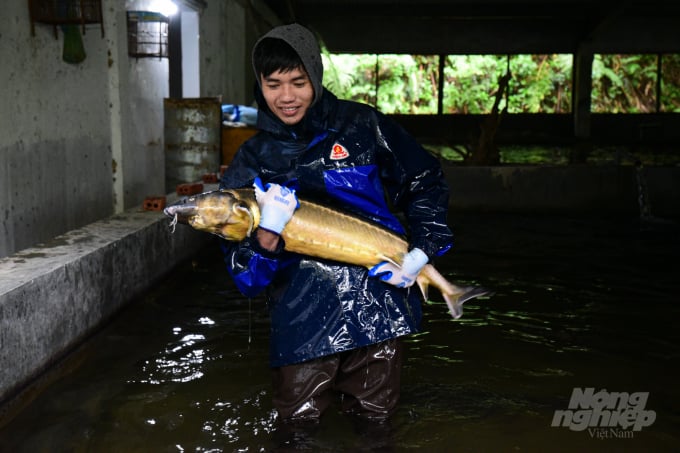
Europe-origin sturgeon raised here are highly regarded for their meat quality. Photo: Tung Dinh.
Note when raising sturgeon
According to Dr. Luu, localities in the Northwest of Vietnam have very favorable natural conditions for sturgeon farming as this species will not eat well if the water temperature is below 12oC. With a natural cold water source, followed by investment in biosecurity infrastructure and good seed sources, the profits and benefits from sturgeon can be assured.
Sturgeon does not have any dangerous diseases at present, but poor water quality can cause fungus to appear. If there is a fungus, it is necessary to bathe the fish in water mixed with specialized solutions.
One more thing to add is that the topography of sturgeon rearing locations is often next to streams and near mountains, so there is a higher chance of floods than usual. Sturgeon farmers should always put the risk of natural disasters into consideration.
Translated by Samuel Pham
![Turning wind and rain into action: [4] Bringing climate bulletins to remote and isolated areas](https://t.ex-cdn.com/nongnghiepmoitruong.vn/608w/files/linhnhp/2025/06/14/1152-z6704423696987_15fd32ffc26d590d204d520c9dac6786-nongnghiep-151141.jpg)
(VAN) The Vietnam Agriculture and Nature Newspaper interviewed Mr. Vu Thai Truong, Acting Head of Climate Change and Environment at UNDP Vietnam, to gain deeper insight into how climate bulletins are delivered to farmers.
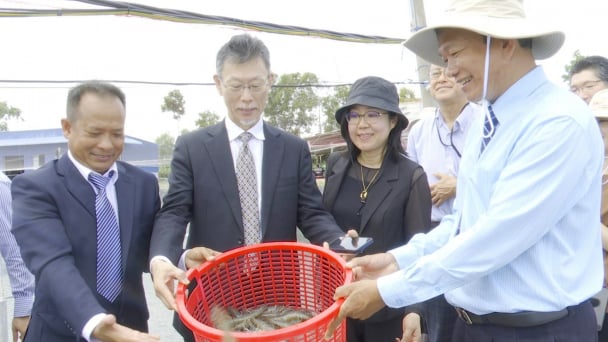
(VAN) In Tien Giang, a high-tech shrimp farm has developed a distinctive energy-saving farming model that has yielded promising results.
![Turning wind and rain into action: [3] 300.000 farmers benefit from agro-climatic bulletins](https://t.ex-cdn.com/nongnghiepmoitruong.vn/608w/files/news/2025/06/12/e5a48259d6a262fc3bb3-nongnghiep-125122.jpg)
(VAN) The agro-climatic bulletin has become a valuable tool for farmers in the Mekong Delta. After more than five years of implementation, the initiative is gradually being expanded nationwide.
![Turning wind and rain into action: [2] Providing forecasts to the people](https://t.ex-cdn.com/nongnghiepmoitruong.vn/608w/files/news/2025/06/12/e5a48259d6a262fc3bb3-nongnghiep-103927.jpg)
(VAN) In addition to improving the quality of hydrometeorological forecasts, putting forecast bulletins into practical use is crucial for production and disaster prevention.
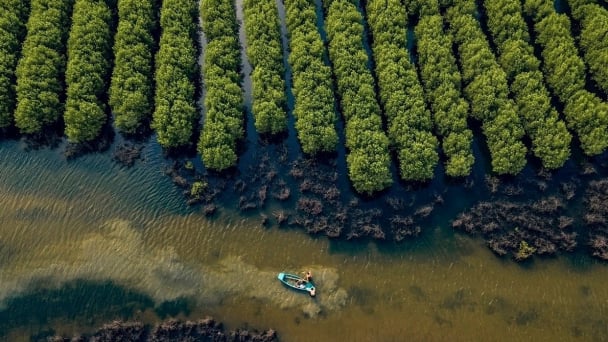
(VAN) Blue carbon is receiving attention for its rapid absorption capacity and vast potential. It represents a promising nature-based solution to respond to climate change.
/2025/06/11/3507-1-161904_583.jpg)
(VAN) Seagrass beds and coral reefs serve as 'cradles' that nurture life in the ocean depths, creating rich aquatic resources in Vietnamese waters.
![Turning wind and rain into action: [1] Forecasting for farmers](https://t.ex-cdn.com/nongnghiepmoitruong.vn/608w/files/news/2025/06/11/e5a48259d6a262fc3bb3-nongnghiep-111919.jpg)
(VAN) Weather is no longer just a matter of fate. Forecasts have now become an essential companion for farmers in every crop season.